[Page 181]
The United Party of Poalei Zion with the S.Z.
by Yehuda Lieberman
Translated by Mira Eckhaus
The history of the united branch of Poalei Zion with the S.Z. in Radomsko, as a
body with organizational and social momentum, begins with the unification
conference of the right wing of Poalei Zion with Tze'irei Zion, which was held
at the end of 1925 in Warsaw. Three delegates from Radomsko participated in
this conference: Aryeh Tzipler, Zisman Ofman (who were perished in the
Holocaust) and Chaim Goldberg (immigrated to Israel in 1935). And immediately
after it, a branch of the united party was organized in our city, where a group
of members of the right wing of Poalei Zion merged with members of S.Z.
Along with the Poalei Zion group that joined the united party were members with
experience in public and party action. Most of them belonged to the Poalei Zion
movement from its early days. Among them, we should mention the member
Mordechai Zelig Rosenblatt, who was one of the founders of the Poalei Zion in
our city and participated as a delegate at the Poalei Zion's world conference
in Krakow in 1912. He was among the opponents of the left current in the party
and with its split, he remained loyal to his views. Among the group of
participants were the members Isidore Auerbach, a representative of Poalei Zion
in the first municipal council that occurred immediately after the
establishment of independent Poland, Wolf Shapira, the Waxman brothers and
others. Together with them joined the united party the two former members of
the “Bund”, Zukin Schreiber and Mordechai Aharon Reicher, who were
“Bund” activists in the city in the years1905/6.
Most of the S.Z members were enthusiastic young people, who did not have much
experience in public action and their main activity was in the
“HeChalutz”, but they all excelled in their dedication to the
movement and their eager for action.
This merge of a group of experienced and representative members with a youth
group eager for action, shortly bore fruit. The party began to operate at an
increased pace and encompassed in its action all areas of life in the city. Its
influence in the public, and especially among the youth, grew and several years
later, with the beginning of the 1930s, it became the strongest and most
organized public body in the city.
The first committee of the united party included the members A. Auerbach, W.
Shapira, A. Zipler, Z. Ofman, M. D. Goldberg, Shlomo Neiman (all perished in
the Holocaust); and the members S. L. Waxman, Chaim Goldberg, Y. Lieberman, M.
Schitenberg, A. Fishlevitz and A. Goldberg (all live in Israel).
The first steps of the united party were accompanied by many difficulties; The
other parties in the city, both on the left and the right wings, did not
receive its appearance with much friendship and fought it at every step. In
addition, it is worth noting that at the time of the establishment of the
united party, the Zionist movement in Poland was in a low point due to the
failure of the fourth Aliyah and the appearance of the “emigrants”
phenomena.
This crisis of the Zionist movement was felt more forcefully in our city, as
the Aliyah from it was much higher in proportion to other larger cities and
hence, the rate of emigrants from Israel was also very noticeable. Among the
“emigrants” were Zionist public activists, who upon their return
became fierce opponents and blamed their failure on the Zionist Organization.
Upon their return, an anti-Zionist atmosphere prevailed in the city and
loosened the hands of the loyalists of the Zionist movement in its various
forms, so that the Zionist parties such as “HaMizrahi”, the
“Ithachdut”, and others reduced their actions.
The crisis in Zionism, which damaged the hopes of the masses of Jews, was
exploited by the communist activists in the Jewish Street. The communist
propaganda penetrated the ranks of the Jewish youth and many of them,
especially among the studying youth, were captured by this propaganda.
The United Party considered, immediately after its foundation, as its first
task the fight against the spirit of despair that prevailed in the Jewish
Street, for the restoration of faith in the path of Zionism and immunizing the
youth against the propaganda of alienation from their people and their national
aspirations.
One of the first actions of the united party was to organize the youth and open
a club for it. The youth group that was organized by S.Z. even before the
unification, formed the nucleus of the youth movement of the united party,
which was called “Freiheit”.
Most of the members of the group lived in the large yard of the Itzkovsky House
at 10 Przedborski St. Most of them were young and devoted to the party Among
its members were: Yaakov and Rachel Lieberman, David and Leah Widislavski, the
brothers Asher and Nathan Grossman, the brothers Yechezkel and Avraham
Dickerman and others. Later, with the establishment of “Freiheit”,
Tuvia Bodikovski (from the Ghetto Warsaw fighters), the late Yechezkel
Skornitski, Yaakov Shmuel Moshkowitz, Avraham Goldberg, Yetta Moshkowitz and
others also joined the party.
This group of activists invested all their time in the youth organization and
established a magnificent branch, which surrounded teenagers, mostly from poor
places, boys who were working from their early youth in order to help their
parents with the livelihood. These boys and girls found warmth and joy in the
youth club after a hard day's work and considered it their home. Educational
work of great importance and bearing results was invested in this youth, most
of whom did not receive a normal education at school age. Study groups
dedicated to various subjects were created, which were persistently and
devotedly managed by the members M. Z. Rosenblatt, Aryeh Zipler, Chaim
Goldberg, Y. Lieberman, M. Schitenberg and others. The joining of Prof.
Bromberg to the educational action among the youth contributed greatly to its
development, and he won the hearts of the boys and girls for his dedicated work
for their benefit (See a special list on page 219 on “Freiheit”).
The second area that the united party approached immediately after the union to
take care of with all the vigor and dedication was the educational and cultural
action.
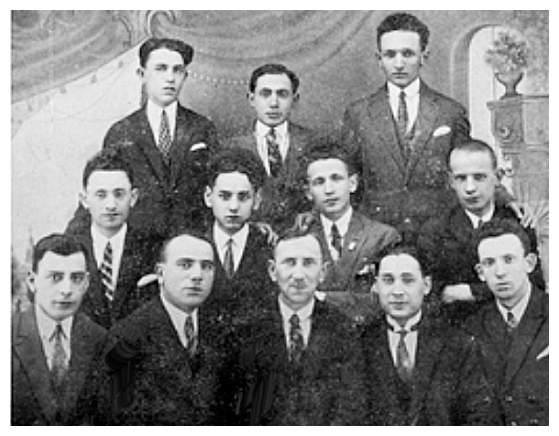 |
| The first committee of the united party
Sitting (from right): Meir-David Goldberg, Aryeh Zipler, Isidor Auerbach, Wolf
Shapira, Zisman Ofman;
Second row — Aharon Fishlevitz, Chaim Goldberg,
Yehuda Lieberman, S. L. Waxman;
Standing: — M.Y. Schitenberg, Shlomo Neiman, Avraham Goldberg (youth
representative).
|
[Page 182]
In May 1926, the library named after Shalom Aleichem was opened. The opening of
the library testified to the organizational momentum of the party and was a
bold and blessed move in the field of culture and education in the city. The
library gathered around it hundreds of readers from all strata and over time
“swallowed up” the small libraries and became the central library in
the city. In the first years of its existence, the books were in Yiddish and
Polish, but in later years, Hebrew books were added to them (that were
collected in Israel and sent by the World Hebrew Alliance to Radomsko).
The library contributed a lot to the education of the youth and was an
important channel of influence for the national and social ideas that the party
advocated (see more about the library and its development in a special list in
the book).
The cultural and educational activity of the party branched out over time and
encompassed many areas. In the 1930s, it founded the People's University, that
gathered hundreds of listeners around it. The university was headed by Prof.
Israel Bromberg and among its lecturers were Dr. Shafir, Dr. Sack of
Czenstochov and others. The university has held dozens of lectures on various
subjects. In the winter season of 1930, 40 lectures on literary, historical and
economic subjects were held at the People's University and were attended by
nearly 4000 listeners.
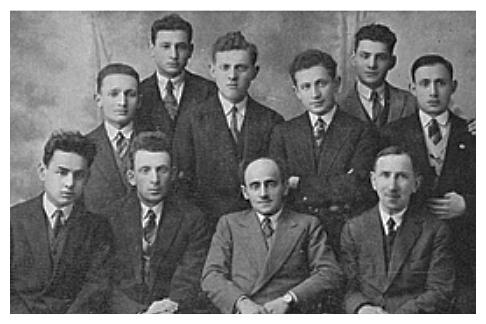 |
| A group of members together with Dr. A. S. Yoris (1930)
Standing (from right to left): Shlomo Neiman, Jacob Lieberman, C. Goldberg, S.
Brenner, Shmuel Neiman, M. Schitenberg.
Sitting: — I. Auerbach, A. S. Yoris, M.D. Goldberg, Y. Lieberman.
|
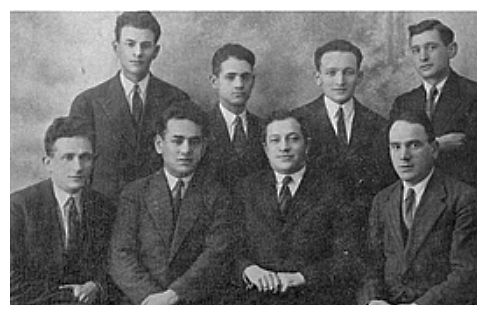 |
| The branch committee members together with A. Bialopolski (1933)
Standing (from right to left): S. Neiman, M. Schitenberg, A. B. Eisen, Y.
Weinterter;
Sitting: W. Shapira, A. Bialopolski, Y. Lieberman, C. Goldberg.
|
Even in 1931, the university was active and popular in the city, but due to
several harassments by the police, who supposedly found a defect in the lecture
hall and defined it as unsuitable for gatherings, the university had to stop
its activities.
The cultural activists in the party established a drama circle, a choir and an
extensive network of evening classes that gathered around them hundreds of
people and fans.
The founding of the “Hapoel” organization contributed greatly to the
development of physical culture among the Jewish youth in the city. The
“Hapoel” developed at a rapid pace and became one of the largest
sporting organizations in the city. The “Hapoel” was engaged in many
sports and included hundreds of members.
In the first years of its existence, the united party concentrated on an
extensive and vigorous propaganda operation. Its first club, in Holzberg's
house, in Shul Gas, was buzzing with vigorous activity. On Shabbat nights we
would hold debate stages, question and answer evenings, etc. Our public
propaganda was accompanied by “heated” debates from the party's
opponents. In addition to the oral activity, we also acted through
proclamations and written circulars, in which we explained our perspective to
the Jewish workers and youth and called them to join our ranks. The party was
aware of what was happening in the world, and in the Jewish world in
particular, and every event, whether it was in the general Jewish area, in the
Zionist movement or in the local area, in the organizational and cultural
activity, found its expression in public meetings, oral conversations and
written letters to the Jewish population in the city.
The extensive and vigorous campaign bore fruit and the influence of the united
party grew more and more in the city. In this action we were helped by the
members who were at the head of the movement in Poland. We were visited by the
members A. Reiss, the late M. Neishtat, N. Tigar, Israel Ritov, the late A.
Bialopolski, the late L. Shpizman, N. Kantaravich, Dr. A.S. Yoris, L. Kroy and
others. I would like to mention the constant help of the member Lazer Levin of
Lodz who was sort of a “resident” of Radomsko even since the time of
the Poalei Zion party before the split. The atmosphere of despair from the
Zionist idea and the wave of alienation from national aspirations backed down
in the face of the onslaught from party activists imbued with the belief in the
rightness of their socialist Zionist way, and with the load of hopes they
carried in their hearts, they swept after them many into the ranks of their
party.
The united party in Radomsko considered its main role as the cultivation of the
socialist Zionist idea in the Jewish Street and in activity in the Zionist
movement. Whether it was in the field of collecting funds for the national
funds and whether it was in the field of Zionist propaganda, but its main
support was given to the Zionist labor movement and its institutions. Its
participation in the League for the Working Land of Israel made it one of the
most active in Poland and fostered the idea of Aliyah and self-fulfillment
among the Jewish youth in the city, brought hundreds of them to join the
“HeChalutz” and the “HaOved”, to go to training and prepare
for Aliyah, and many of them also had the opportunity to immigrate and they now
live in Israel.
As a workers' party that was well rooted in the city, the united party did not
abandon the roles imposed on it by the conditions of the place and the
environment.
The members of the party who belonged to the trade unions experienced a hard
struggle for their rights to organize and perform advocacy action, and the
party assisted them and began a campaign against the leaders of these unions,
who tried to harm the rights of our members. This struggle was long and
difficult and mainly concentrated in the sewing and the leather professions,
which were in the hands of the left-wing Poalei Zion party and the communists.
In the 1930s, a center was established in the city for the trade unions that
belonged to the Working Land of Israel movement.
[Page 183]
The party took an active part in the work of the center in both improving
working conditions and in organizing support for the labor movement in Israel
and in fostering immigration to Israel, and indeed many of the center's members
were privileged to immigrate to the Land of Israel in the framework of
“HaOved”.
With the beginning of the 1930s, the united party departed the period of its
organization and the struggle for its place among the other parties in the city
and became an established and well-known party, which had a hand in everything
that was done in the public sphere and even managed to stand at the head of the
action in certain areas.
In the community elections held in 1931, the united party had a considerable
victory when two of its members, Z. Schreiber and M. A. Reicher, were elected
as members of the community council and the member Z. Shapira was elected as a
member of its management, and was later appointed the deputy chairman of the
community in Radomsko.
It was an unexpected victory, because the right to vote for the community was
limited to men only and this institution had always been in the hands of the
ultra-orthodox.
Another success in the municipal territory was the election of the
representative of the united party, the member A. B. Eisen to the city council.
It should be noted that the representation in the municipality was for many
years in the hands of the left wing of Poalei Zion party and the replacement of
their representation by the united party involved a fierce struggle.
The united party considered itself as part of the workers' movement and as a
partner in its ambitions for the liberation of the working man, and starting in
1926, party members participated in the May 1st celebrations in the city, often
jointly with other Jewish workers' parties and the Polish Socialist Party
(P.P.S.).
*
This is how the united Poalei Zion party in Radomsko turned from a humble body
that was established in a period of despair from the ideas it espoused and had
to fight to prove the righteousness of its way, to the most powerful Jewish
party in the city, whose activities branched out and expanded and surrounded
all the areas of public life in the city.
This branching is evidenced by the multiple institutions in which the party
operated and the large number of clubs it established, starting from the first
club in Holzerberg's house (Shul Gas) to the spacious “Borochov Heim”
at 40 Raymonta St. with its large hall and the many rooms in which the various
party institutions were concentrated.
And when I ask myself what was the secret of the strength of this party, which
knew how to overcome so many difficulties and succeed where others failed, I
find it in the following points:
-
In the self-education towards the socialist Zionist way and in the tight
connection with the labor movement in Israel.
- In the pursuit of self-fulfillment. We did not preach Zionism to others, but
prepared ourselves for the Aliyah. This hallmark of self-fulfillment prevailed
at all of the party's activists at all levels, from its veteran activists to
the graduates of “Freiheit”.
- In the internal unification that prevailed among the members of the party
and the feeling of brotherhood that united the group that headed it from the
beginning of the union, known also as “the fourth”, that included the
members the late A. B. Eisen, (who perished in the Holocaust), Chaim Goldberg,
M. Schitenberg and the writer of these lines. Before us was one and only goal
– the movement, to which we devoted ourselves completely. This dedication
served as an example for many members, who contributed their part to the party
for its development and glorification.
The devotion to the Zionist idea was also a hallmark of the other movements and
parties that belonged to the Zionist movement, but the members of our party, as
noted above, knew how to fill their organizational framework with practical
content. This content was based on the assumption that as long as we operate in
the diaspora, the local public action must be combined with the desired goal of
socialist Zionist training and immigration to the Land of Israel, that is, not
a negation of the diaspora but action within it for the sake of the entire
Jewish public, which the Zionist part in it considered its future in leaving
the diaspora and building a new life in the Land of the Fathers.
The united Poalei Zion party in Radomsko, as a party whose immigration to
Israel was at the top of its agenda, had the privilege of having some of its
members immigrate to Israel and cling to it, but most of its members knocked in
vain on the gates of the country and were unable to enter it. These lines are
dedicated to those members who remained in the diaspora and perished in the
annihilation that came upon the House of Israel by the Germans.
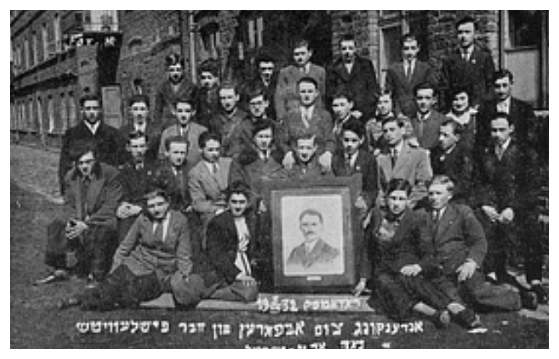 |
Members of the “Freiheit” at
the farewell party on the occasion of the immigration to Israel
of the member Aharon Fishlevitz (1932)
Top row (from
the right): A. Birnbaum, S. Grenk, Rushatsky, Fishel Zandberg, H. Zuckerman
Second row: H. Zipler, Sarah Fishman, L. M. Moshkowitz, Binyamin Stein, Yaakov
Wanglinsky,
Label Winter, Yechezkel Dickerman, Birnzweig.
Third row: Shlomo Neiman, D. M. Kornberg, Shmuel Neiman, Y. Lieberman, A. Fishlevitz,
C. Goldberg, A. B. Eisen, M. Y. Schitenberg, Y. Skornitsky, S. Brenner;
Below: —, Y. Brenner, —, Tuvia Mendel, Berl Kribis.
|
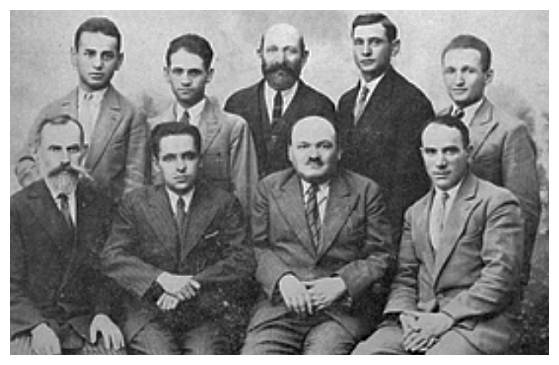 |
| The party's committee in 1932
Standing (from the right): M. Schitenberg, S. Neiman, M. A. Reicher, A. B.
Eisen, Y. Lieberman;
Sitting: W. Shapira, L. Levin (Lodz), Yechezkel Rabinowitz (Slonim), Zaken Schreiber.
|
[Page 184]
The National Religious Movements
by B. Ben-Yehoshua
Translated by Mira Eckhaus
Our city of Radomsko, the city of “Tiferet Shlomo”, was a city that
had “everything in it”: Chassidim of all kinds, fierce opponents and
scholars, houseowners and laborers and God-fearing people who are well versed
in the “Otiyot Ktanot” (small letters). The similarity in all of them
was in their love of Israel and their longing for Israel. Among them were
elders wise scholars, such as Rabbi Mendele Frankel (may God avenge him), the
brother-in-law of the Rebbe of Radomsko, who himself was a descendant of the
Rebbes of Hanchin and Fiscena. He was a dear Jew, in whom dwell both the
greatness and the Torah. And in the same way he showed a great love for every
Jewish matter and especially for the Land of Israel. Rabbi Mendele did not fear
the derision nor the mockery of the detractors, and united with the
“common people” in order to found the Histadrut of the
“Mizrahi” in the city.
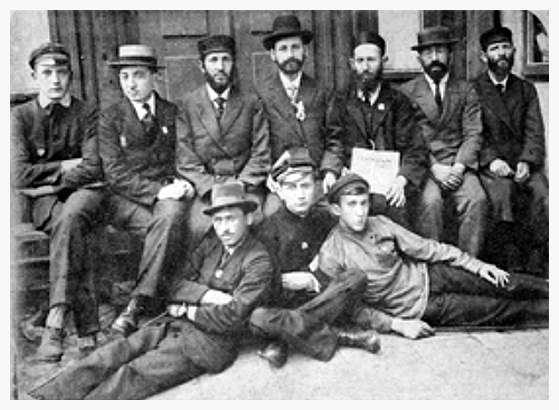
The teachers' member of
the Mizrahi school (in 1919):
Top row (right to left) – Rosenzweig, Meisel, Grant, school principal,
Hirsch, Aharonovitz,
—, bottom (first from left) Hashchevtzsky David.
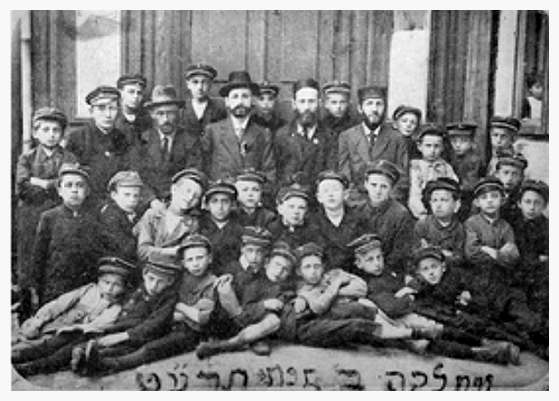
A group of teachers of the “Mizrachi” school (in 1919) with second
class students
The second in importance was Rabbi Avraham Moshe Waxman, a very respected and
honored person, who threw everything behind and devoted most of his time and
energy to the affairs of the Land of Israel and fulfilled personally the verse:
“with all your heart” and had the privilege of immigrating to Israel
(he and his wife, who made a living here on a small scale, passed away at an
advanced age in Jaffa). Avrahamtchi Minsky, a Jew of great traits, served as
the secretary for Jewish affairs in the city (magistrate) and was determined
with all his heart to do favors for every Jew, regardless of party or lineage
status. Reb Mendele Fischhof was a wealthy merchant who was willing to close
his shop in the middle of the day in order to collect money to the Jewish
National Fund or to fulfill whatever task the party imposed on him. He was weak
in body but with a noble spirit and an honest opinion. Reb Leibel Zilberberg
(the Shpiliter – traveling agent), one of the first Hovevei Zion members,
man of letters and well-mannered, who was willing to give his life to do a
favor to a Jew.
Reb Shlomo Naimark had a gentle soul and was a rich merchant. Similar to them
were Reb Yehuda Salzman, Mordechai Rosenzweig (he and his sons who were among
the first founders), Michael Waxman, Yaakov Hartman, Reuven Lieberman, Yaakov
Yudkevich, Avraham Ze'ev Goldberg and Yechiel Shlomo Shittenberg, the late
Yehoshua Elazar Rabinovitch, and may they live a good and long life, Reb Shlomo
Rabinovitch, one of the first to settle in Kfar Hasidim, and the teacher
Binyamin Yemini (Karamzin) who was one of the founders of the Mizrahi School
and its director until the day he immigrated to Israel.
The beginning of this organization was underground, in the “Fallush”
of Kopel, the shamash of the Beit Midrash. Kopel was one of Dr. Herzl's
admirers and despite being supported by the houseowners, the worshipers of the
Beit Midrash – his heart was open to everything in Zionism. He was ready
to give up the livelihood of the shamash (shamoshes) in the Beit Midrash of the
holly congregation Radomsko and immigrate to Israel. It is my duty to mention
two veteran Hovevei Zion, who were devoted in heart and soul to the Zionist
idea, and they are Rabbi Moshe Lebkowitz, the “minstrel” of the city,
who considered it a sacred duty to play at every Jewish wedding songs of Zion
that spoke to the heart and shed tears of sadness, grief and longing for Israel
and its sanctuary, and last but not least, Rabbi Michael Wassertreger (the
water pumper) who was the first Hovev Zion in the city. He sent all his savings
to London to buy one share of the Jewish Settlement Treasury. It was told about
him, that when he received the share, he wore Shabbat clothes, went up the
spring hill, holding the share in one hand and the pole and the buckets in the
other hand and blessed: “she'hecheyanu vikiyimanu vihigiyanu lazman
hazeh” (that you kept us alive, sustained us and brought us to this
occasion). He sang “Hatikvah”, danced out of joy and sang: “Work
is our life, it will save us from every trouble… in our country.” He
was an innocent Jew and passionate about the idea of immigrating to Israel and
building it. There were many more like him and their name will be mentioned in
the book.
All of these carried the burden of the movement and devoted the best of their
energy and time to the idea of “the Land of Israel for the people of
Israel, according to the Torah of Israel.” They collected funds at every
opportunity for the benefit of the Jewish National Fund, the Redemption Fund,
and every charitable matter. Their reward was disgrace and blasphemy that they
received from their opponents, “Zion's haters”.
The foundation of the “Mizrahi” School
In 5666 (1916), the Hebrew national religious school, the first in the city and
the surrounding area, was founded by the Mizrahi. It was headed by Reb Mendele
Frankel, his deputy – Reb A. M. Waxman, Reb Shlomo Rabinowitz, and his
secretary Binyamin Yemini (Karamzin).
[Page 185]
It was a bold step to do such a thing in the city of Radomsko and its hostile
environment without any budget or support. On the other hand, there was
enthusiasm for the need of the hour. The state of education in Radomsko was
similar to that in other Polish cities in those days. Every
“non-successful” person would serve as a young teacher and teach
Torah while using a stick and a leash. Many left the cheder and went to gentile
schools and many remained ignorant – only few were privileged to reach
Talmud studies. Of course, there was a great commotion in the city: the
“Mizrahi” came to distance our sons from their God-fearing. They will
learn the Bible… and Hebrew in Hebrew! And even gymnastics and singing and
everything else that is forbidden. However, the people of Mizrahi did not
hesitate, they continued and succeeded in their mission. Within one year, the
school was filled completely and despite the boycott, the slanders and the
expulsions from Gur's Shtiebel, Jews sent their sons to the Mizrahi school. To
the school's praise it must be said: it was non-partisan and accepted any
student whose parents wanted to give him an orderly traditional education.
Also, there was no discrimination between the rich and the poor. The school's
committee was represented by all the Zionist parties: Reb Mendele Frankel
served as the chairman, Reb Shlomo Rabinovitch was his deputy, Reb Shlomo
Krakowski, who died in Israel, Reb Hillel Zumbek (general Zionist) served as
the treasurer, H. Feingold (general Zionist), the late member of the committee
Reb Yitzchak Aharonovitz, and many more. The teacher Binyamin Yemini (Karamzin)
assumed the management, not in order to receive an award, and managed it until
the day he immigrated to Israel. The best teachers in the field of education in
those days were invited to serve as teachers: H. Hirsch, H. Grant, H.
Hashchevtzsky, H. Meisel and more. The chazan (cantor) of the city, Reb Shlomo
Zaks, taught Hebrew-Zionist poetry and young Zionists taught Polish,
gymnastics, etc. The director H. Yemini also taught sacred studies.
A Hebrew library was founded next to the school, and anyone who asked for a
Hebrew book would come and get one. The wise parents were relieved when they
saw their sons return from school with politeness and good manners, dressed in
a light blue and white outfit, their heads crowned with a blue and white hat
with the Mizrahi symbol – in the shape of a rising sun sending its rays
from the east. They were happy to hear their sons speak and sing in Hebrew and
know how to explain a chapter in the Torah, in the Bible and in the Talmud.
When the pressure of the Shtiebel of the Gur's Chassidim increased and they
decreed that everyone who sends his son to the school of Mizrahi is not allowed
to come in the crowd, the people of the Mizrahi arranged them a Minyan in the
school, at the house of Shamai Blacher (the tinsmith). Of course, all the money
paid for the vows and alms was kept for the sacred Jewish National Fund. There
was a great influence of the Mizrahi on the true Hovevei Zion, to leave the
bitter exile and immigrate to the Land of Israel. Among the first to immigrate
to Israel were Mr. Binyamin Yemini (Karamzin), Reb Yaakov Sofer (the father of
our friend M. Hatumi), Reb Avraham Moshe Waxman and his wife, Shlomo Rabinowitz
and others.
In 1924, many of the Radomsko people immigrated to Israel and took part in the
building of “the center of Tel-Aviv”, they built many large houses,
but, unfortunately, they could not withstand the crisis of those days and
returned to Radomsko. Pity on those who were lost and not forgotten, who
perished in the Holocaust!
In addition to the education, the Mizrahi was engaged in the organization of
the religious youth for the benefit of building the country. This is how the
organization “Tze'irei Mizrahi” branched out and was founded, whose
leaders were: Reuven Goldberg, Meir Karfka, the three brothers: Yaakov, Moshe
and Yeshayahu Rosenzweig, Elimelech Schittenberg, Avraham Wolf Goldberg, Hillel
Yodkevich, Shlomo Volodovsky, Getzil Eilenberg, Yehoshua Elazar Rabinovitch,
Raphael Rappaport , David Margolevsky and others.
The “HeChalutz” of Mizrachi was founded on the initiative of Shlomo
Yechiel Vorshatsky and his friends, who received permission to
“engage” in agricultural work in the yard of H. Eichner's house in
the city. Among the founders were: Hillel Yodkevich, Chaim Hamer, Moshe
Rabinovitch, Nachum Hocherman, Laibel Shmolevich and Gershon Kokochinsky (the
son of Rabbi Shamai Melamed). The young members' operation did not shame the
legacy of the elder members: they invited lecturers from outside the city, held
classes every Shabbat, sent propaganda emissaries outside the city and founded
a real agricultural farm outside the city, where immigrants were trained in
agricultural work and where they instilled the idea of the religious pioneer in
the hearts of the youth. Every lecturer who came to the city, caused flared
tempers among both sides, those who prepared to listen to his words, and those
who prepared for a “mitzvah war”. The war between both sides
increased especially when it was known that the girls of the city were also
organizing, this thing crossed the limits. This was the view of the exile
– Israeli girls in a gentile school is the decree of the kingdom and is
“dina d'malkuta dina”, but an organization of the girls for the
return of Zion! Has anyone heard about an act like this? And this was where the
holy rebellion of the girls took place and they organized themselves under the
name “Bruria”. The activists' members among them were: the daughters
of Reb Mendel Frankel; the daughters of Eichner; the daughters of H.
Shwiatlovsky; the daughters of H. Rapoport; the daughters of Reb Herschel
Tochmeir; the daughters of Tiger. They constituted the religious intelligentsia
in the city. In the diaspora they were engaged in collecting funds and training
and spreading Hebrew culture for the purpose of training the youth to immigrate
to Israel. Some of them were privileged to immigrate to Israel and build their
homes there.
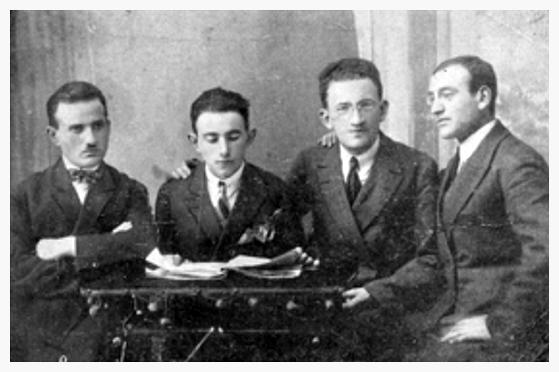
The first “Tze'irei Mizrahi”.
From right to left: Moshe Rabinowitz, A. W. Goldberg, Moshe Hirschberg, Meir
Levkowitz.
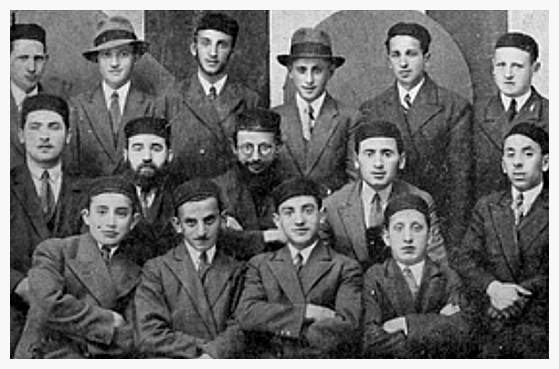
The members of “Tze'irei Mizrahi” in 1933
Top row (right to left) – Yosef Perzhdborsky, Yochanan Petkur, Y.
Rosenzweig, Strubinsky,
Israel Rosenzweig, Fishel Weiss;
Second row: Laibel Shmolevich, Raphael Rappaport, Yeshayahu Eliezer Rabinowitz,
Hillel Yodkevich, Poznansky; Third row: A. Hamer, Yitzhak Hamer, Strobinski, Shaya.
This material is made available by JewishGen, Inc.
and the Yizkor Book Project for the purpose of
fulfilling our
mission of disseminating information about the Holocaust and
destroyed Jewish communities.
This material may not be copied,
sold or bartered without JewishGen, Inc.'s permission. Rights may be
reserved by the copyright holder.
JewishGen, Inc. makes no representations regarding the accuracy of
the translation. The reader may wish to refer to the original material
for verification.
JewishGen is not responsible for inaccuracies or omissions in the original work and cannot rewrite or edit the text to correct inaccuracies and/or omissions.
Our mission is to produce a translation of the original work and we cannot verify the accuracy of statements or alter facts cited.
 Radomsko, Poland
Radomsko, Poland
 Yizkor Book Project
Yizkor Book Project
 JewishGen Home Page
JewishGen Home Page
Yizkor Book Director, Lance Ackerfeld
This web page created by Osnat Ramaty
Copyright © 1999-2024 by JewishGen, Inc.
Updated 03 Jun 2023 by OR











